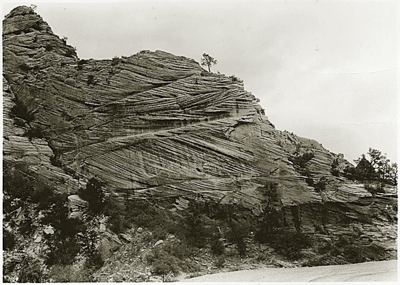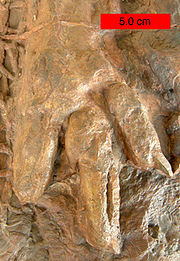
Way up structure
Encyclopedia
A way up structure, way up criterion, or geopetal indicator is a characteristic relationship observed in a sedimentary or volcanic rock, or sequence of rocks, that makes it possible to determine whether they are the right way up (i.e. in the attitude in which they were originally deposited) or have been overturned by subsequent deformation. This technique is particularly important in areas affected by thrusting
and where there is a lack of other indications of the relative ages of beds within the sequence, such as in the Precambrian
where fossils are rare.
The original definition comes from Bruno Sander in 1936, translated from German to English in 1951, which states:


Thrust fault
A thrust fault is a type of fault, or break in the Earth's crust across which there has been relative movement, in which rocks of lower stratigraphic position are pushed up and over higher strata. They are often recognized because they place older rocks above younger...
and where there is a lack of other indications of the relative ages of beds within the sequence, such as in the Precambrian
Precambrian
The Precambrian is the name which describes the large span of time in Earth's history before the current Phanerozoic Eon, and is a Supereon divided into several eons of the geologic time scale...
where fossils are rare.
The original definition comes from Bruno Sander in 1936, translated from German to English in 1951, which states:
Geopetal Fabrics - All the widely distributed spacial characters of a fabric that enable us to determine what was the relation of "top" to "bottom" at the time when the rock was formed are termed geopetal fabrics. Such fabrics are mechanical and chemical internal deposition; grains on a boundary surface; cross-bedding, etc.
Examples


- UnconformitiesUnconformityAn unconformity is a buried erosion surface separating two rock masses or strata of different ages, indicating that sediment deposition was not continuous. In general, the older layer was exposed to erosion for an interval of time before deposition of the younger, but the term is used to describe...
- Clear angular unconformities provide unequivocal evidence of the relative age of two rock sequences. - Cross-beddingCross-beddingIn geology, the sedimentary structures known as cross-bedding refer to horizontal units that are internally composed of inclined layers. This is a case in geology in which the original depositional layering is tilted, and the tilting is not a result of post-depositional deformation...
(aka Cross-stratification) - These structures are common in rocks laid down by the action of wind or water currents and in some volcaniclastic rocks. Minor erosional events during the overall deposition give rise to small-scale angular uncomformities. There are three ways a cross bed can be used:- Troughs of trough cross beds, in which the concave part of the trough points up.
- The tangential (end) part of the cross bed is always on the bottom of the cross bed.
- Many cross beds are stacked, and truncation always happens up section.
- Graded beddingGraded beddingIn geology, a graded bed is one characterized by a systematic change in grain or clast size from the base of the bed to the top. Most commonly this takes the form of normal grading, with coarser sediments at the base, which grade upward into progressively finer ones...
- In certain types of clastic sedimentary rock, the grain or clast size varies systematically from the base of the bed to its top. In a normally graded bed the grain or clast size is largest at the base and the bed is said to fine upwards. Beds deposited by density underflows such as turbidites typically show normal grading. Reverse grading or coarsening upwards is a characteristic of some alluvial fanAlluvial fanAn alluvial fan is a fan-shaped deposit formed where a fast flowing stream flattens, slows, and spreads typically at the exit of a canyon onto a flatter plain. A convergence of neighboring alluvial fans into a single apron of deposits against a slope is called a bajada, or compound alluvial...
deposits, so it is important to understand the depositional environmentSedimentary depositional environmentIn geology, sedimentary depositional environment describes the combination of physical, chemical and biological processes associated with the deposition of a particular type of sediment and, therefore, the rock types that will be formed after lithification, if the sediment is preserved in the rock...
before using this particular criterion. - Sole markingsSole markingsSole marks are sedimentary structures found on the bases of certain strata, that indicate small-scale grooves or irregularities. This usually occurs at the interface of two differing lithologies and/or grain sizes. They are commonly preserved as casts of these indents on the bottom of the...
- Many beds deposited by density underflows, such as turbiditeTurbiditeTurbidite geological formations have their origins in turbidity current deposits, which are deposits from a form of underwater avalanche that are responsible for distributing vast amounts of clastic sediment into the deep ocean.-The ideal turbidite sequence:...
s, have erosional bases. Although there is no clear angular uncomformity developed in most cases, there are characteristic structures formed at the base of the bed. Also includes are flute casts, grooves, and tool marks. - Load casts - These are formed when a higher density layer (e.g. a sand) is deposited on a lower density layer (e.g. a mud). Characteristic structures include flame structureFlame structureA flame structure is a type of soft-sediment deformation that forms in unlithified sediments. The weight of an overlying bed forces an underlying bed to push up through the overlying bed, generally when both strata are saturated with water...
s that are forced up from the underlying low density layer. - MudcrackMudcrackMudcracks are sedimentary structures formed as muddy sediment dries and contracts.- Formation :...
s - Cracks in a desiccated mud layer, such as found on a dried-out lake bed or tidal flatMudflatMudflats or mud flats, also known as tidal flats, are coastal wetlands that form when mud is deposited by tides or rivers. They are found in sheltered areas such as bays, bayous, lagoons, and estuaries. Mudflats may be viewed geologically as exposed layers of bay mud, resulting from deposition of...
, are often filled by an overlying sand layer. Mudcracks in cross section typically show a profile in which it is narrow at the bottom and wider at the top. - Ripple marksRipple marksIn geology, ripple marks are sedimentary structures and indicate agitation by water or wind.- Defining ripple cross-laminae and asymmetric ripples :...
- Ripples are typically rounded at the base (trough) and sharp (or truncated) at the top (crest). - Neptunian dykes - These are formed when the top of a bed is temporarily exposed and a fissure develops by processes such as earthquake activity or solution of carbonates. The fissure becomes filled either during the period of exposure by contemporaneous, possibly wind-blown material, or when deposition resumes, by the same material as the overlying bed.
- Rubbly tops and chilled bases of lava flows - Basaltic lava flows often have bases that show evidence of rapid cooling against the land surface and broken, rubbly tops caused by the continued flow of partially solidified lava.
- Pillow structurePillow lavaPillow lavas are lavas that contain characteristic pillow-shaped structures that are attributed to the extrusion of the lava under water, or subaqueous extrusion. Pillow lavas in volcanic rock are characterized by thick sequences of discontinuous pillow-shaped masses, commonly up to one metre in...
s in subaqueous lava flows. - Trace fossilTrace fossilTrace fossils, also called ichnofossils , are geological records of biological activity. Trace fossils may be impressions made on the substrate by an organism: for example, burrows, borings , urolites , footprints and feeding marks, and root cavities...
s - The trails of bottom feeders such as Cruziana, u-shaped burrows of suspension feeders such as Diplocraterion and traces of root systems can provide clear evidence of way-up. - Fossils in life position (e.g. coralCoralCorals are marine animals in class Anthozoa of phylum Cnidaria typically living in compact colonies of many identical individual "polyps". The group includes the important reef builders that inhabit tropical oceans and secrete calcium carbonate to form a hard skeleton.A coral "head" is a colony of...
, articulated crinoidCrinoidCrinoids are marine animals that make up the class Crinoidea of the echinoderms . Crinoidea comes from the Greek word krinon, "a lily", and eidos, "form". They live both in shallow water and in depths as great as 6,000 meters. Sea lilies refer to the crinoids which, in their adult form, are...
s) can give a paleo up direction. - Void-fill structure (known in some texts as simply a geopetal structure) is a void or cavity in a rockRock (geology)In geology, rock or stone is a naturally occurring solid aggregate of minerals and/or mineraloids.The Earth's outer solid layer, the lithosphere, is made of rock. In general rocks are of three types, namely, igneous, sedimentary, and metamorphic...
that has been part-filled with sediments or mineralMineralA mineral is a naturally occurring solid chemical substance formed through biogeochemical processes, having characteristic chemical composition, highly ordered atomic structure, and specific physical properties. By comparison, a rock is an aggregate of minerals and/or mineraloids and does not...
deposits, that indicates an initial horizontal that can be used as a way up structure and as a precise measure of post-depositional tilting. There are two main examples of this:- Fossils - Any fossilFossilFossils are the preserved remains or traces of animals , plants, and other organisms from the remote past...
that starts with a significant internal cavity may develop such structures, like molluscs and brachiopods. The initial fill is often of sediments with the remaining part filled by calciteCalciteCalcite is a carbonate mineral and the most stable polymorph of calcium carbonate . The other polymorphs are the minerals aragonite and vaterite. Aragonite will change to calcite at 380-470°C, and vaterite is even less stable.-Properties:...
, giving a clear geopetal structure. - Vesicles - Many lavaLavaLava refers both to molten rock expelled by a volcano during an eruption and the resulting rock after solidification and cooling. This molten rock is formed in the interior of some planets, including Earth, and some of their satellites. When first erupted from a volcanic vent, lava is a liquid at...
s are vesicularVesicular textureVesicular texture is a volcanic rock texture characterised by a rock being pitted with many cavities at its surface and inside. The texture is often found in extrusive aphanitic, or glassy, igneous rock...
in the upper part of a flow. These vesicles are often infilled by minerals (especially zeoliteZeoliteZeolites are microporous, aluminosilicate minerals commonly used as commercial adsorbents. The term zeolite was originally coined in 1756 by Swedish mineralogist Axel Fredrik Cronstedt, who observed that upon rapidly heating the material stilbite, it produced large amounts of steam from water that...
s) and/or weathering products from the lava to form an amygdaloidal texture. Some two-phase amygdalesAmygduleAmygdules or amygdales form when the gas bubbles or vesicles in volcanic lava are infilled with a secondary mineral such as calcite, quartz, chlorite or one of the zeolites. Amygdules usually form after the rock has been emplaced, and are often associated with low-temperature alteration. Amygdules...
, such as where a mineral has grown in a vesicle that was part-filled by fluid affecting the mineral form (e.g. opalOpalOpal is an amorphous form of silica related to quartz, a mineraloid form, not a mineral. 3% to 21% of the total weight is water, but the content is usually between 6% to 10%. It is deposited at a relatively low temperature and may occur in the fissures of almost any kind of rock, being most...
versus calcedony), can be used as geopetal structures.
- Fossils - Any fossil

